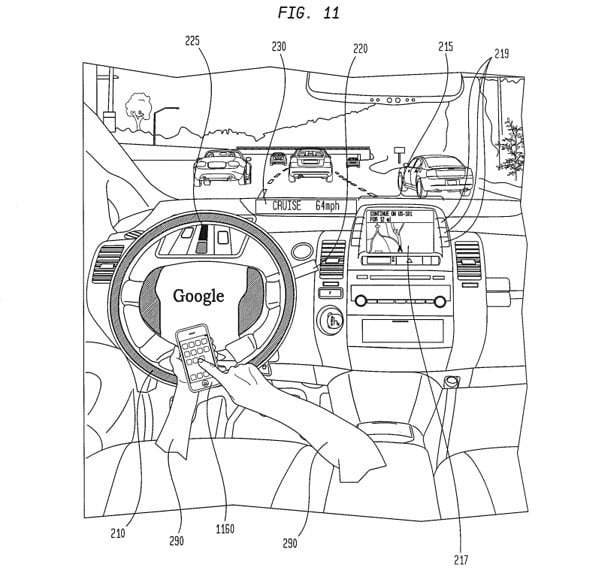Is This Why Google Doesn’t Want You to Drive?
Google has never said exactly how it will make money off the self-driving vehicles it has been developing. Will it manufacture cars? Try to become the operating system for our highways?

I think one answer could be a lot simpler.
It struck me while reading a patent on automated vehicles that was issued to Google on January 8th of this year. The patent, titled “User interface for displaying internal state of autonomous driving system,” covers the idea of a vehicle dashboard that uses lights to cue a driver when it’s safe to relinquish control of their vehicle to a computer.
The patent includes an extremely telling schematic (shown above) of a driver behind the wheel of a self-driving car. Because what will people do when the car is driving? Obviously, they’re going to play with their iPhones.
While Google has never said how it plans to commercialize automated vehicles, it’s clear that keeping people’s eyes on the Web instead of on the road could itself mean a substantial boost to the company’s revenues. Based on my wife’s use of her phone during road trips, I estimate it’s actually worth billions of dollars in new search revenue to Google.
Baloney, you say. Well, getting people to use Google services instead of doing something else is already a key strategy of Google’s. That is one reason the company can afford to maintain its free Android operating system for smartphones. All those phones mean more people on the Internet, searching via Google, and clicking on ads.
So just how much could Google earn by making sure drivers are not distracted from the Internet? Here’s my calculation, based on U.S. Census data:
There are 250 million adults in the U.S., of which 119 million work. Of those, 76 percent drive to work alone spending about 25 minutes to get there. Round trip, call it an hour. Times 260 workdays per year. That comes to about 23,514,400,000 extra person-hours a year to play with phones out of about 1,460,000,000,000 hours American adults spend awake each year. Or about 1.6% more free time overall.
Given Google’s revenue of $46 billion a year (and assuming the rest of the world behaves like Americans) the calculation suggests that by freeing up commuters to surf the Internet driverless cars are worth an additional $736 million in search revenue to Google.
But because Americans account for more of Google’s business than most people on the planet, because commuting is not the only driving we do, and because there’s no better time for playing on a computer than in the car, I’m going to add my own patented fudge factors and say it’s worth $2 billion a year in search revenue to Google to prevent people from driving.
Oh, and let’s not forget the point of this patent: Google’s car will tell you when it’s safe to start searching.
Keep Reading
Most Popular
Large language models can do jaw-dropping things. But nobody knows exactly why.
And that's a problem. Figuring it out is one of the biggest scientific puzzles of our time and a crucial step towards controlling more powerful future models.
How scientists traced a mysterious covid case back to six toilets
When wastewater surveillance turns into a hunt for a single infected individual, the ethics get tricky.
The problem with plug-in hybrids? Their drivers.
Plug-in hybrids are often sold as a transition to EVs, but new data from Europe shows we’re still underestimating the emissions they produce.
Stay connected
Get the latest updates from
MIT Technology Review
Discover special offers, top stories, upcoming events, and more.